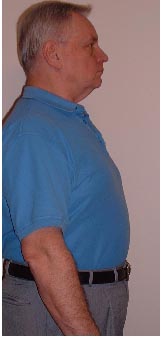FRED SAUTTER- SOUND THE TRUMPET
| YOGA EXERCISES AND BREATH CONTROL |
|
Breath control is universally considered the most important aspect of playing a brass instrument. It is often spoken of, but seldom is anything specifically done. Air is the fuel that "makes wind instruments go," and it is a natural conclusion that any improvement in the efficiency of the use of this fuel would improve one's playing. A large capacity is important, and when blowing the air should flow fast. The results will be realized in every area of playing. Why not then isolate breathing exercises as we do other techniques such as tonguing, lip slurs, and fingering? A concentrated effort on the following Yogi breathing exercises will help bring the desired results. The Complete Yogi Breath

 The Yogi Cleansing Breath Inhale a COMPLETE BREATH, retain a few seconds. Pucker the lips as if whistling (do not seal lips), then exhale a little air with vigor. Stop for a moment, retaining air, then exhale vigorously again.Repeat until all air is expelled. Notice it is the glottis, not the tongue, throat, or lips which control the expulsion of air. The cleansing breath is good for clearing one's head in an afternoon slump or during a late-day session. The Retained Breath Inhale a COMPLETE BREATH and retain as long as comfortable possible and in a relaxed manner. Exhale vigorously through the open mouth and follow up with the CLEANSING BREATH. Retention will improve with practice. This exercise helps the lungs to become accustomed to being full. It adds to the feeling of power needed in sustained loud passages. Walking Exercise Walk with good posture and measured tread. Inhale a COMPLETE BREATH over eight steps. Exhale slowly through the nostrils over eight steps. Rest between breaths, continuing to walk and count. Repeat until tired. The exercise can vary in counts. It should also be done while sitting and counting silently in rhythm. Many professional players and advanced students tried these exercises and related them to their playing. They all agreed that the single most important gain was an increased realization of how vital air (and the speed of it) is to playing. Increased capacity, more awareness of how much air should be used, when actual blowing starts, and improved tone quality, especially in the extremes (loud, soft, low, high), were some of the outgrowths. Rhythmic breathing is related to the body's natural rhythm, i.e., the autonomic nervous system. All musicians consulted agreed that loss of nerve control is loss of breath control. It is important to realize that breathing in a regular manner is not only a result of a relaxed nervous system, but also that one can influence this nervous system to calm down in difficult passages by breathing deeply and in rhythm. Locking or freezing on an attack is another common problem. Practicing correct attacks with rhythmic breathing, without the instrument and the psychological problems attached to it, then adding the instrument, is a great aid in curing this problem. Here is just one exercise which can be practiced: Breath in rhythm, start the tone immediately at the end of the inhalation, carry through with the tone, that is, don't let the tone die. This exercise can be done with and without the instrument and in all registers. Another good trial is to compare how one plays a loud note with regular methods, then take a complete Yogi breath and without pausing, blow the same note as before. There will be more resonance, volume, and sustaining ability. With this amount of "fuel," mutilation of the lips when playing sustained loud passages is not necessary. Just a few examples have been stated for the application of these exercises, and are limited only by one's imagination. Try starting each day with some breathing exercises to wake up the lungs, body, and mind. Then use your lip flexibility exercises in a warm-up, always thinking of how you breathe and what you do with this "fuel."
|